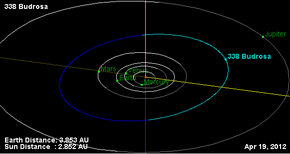338 Budrosa
Appearance
 Orbital diagram | |
| Discovery | |
|---|---|
| Discovered by | Auguste Charlois |
| Discovery date | 25 September 1892 |
| Designations | |
| (338) Budrosa | |
| Pronunciation | /bʊˈdroʊsə/ |
Named after | (unknown) |
| 1892 F | |
| Main belt | |
| Orbital characteristics[1] | |
| Epoch 31 July 2016 (JD 2457600.5) | |
| Uncertainty parameter 0 | |
| Observation arc | 123.53 yr (45120 d) |
| Aphelion | 2.9782 AU (445.53 Gm) |
| Perihelion | 2.84739 AU (425.963 Gm) |
| 2.91280 AU (435.749 Gm) | |
| Eccentricity | 0.022453 |
| 4.97 yr (1815.8 d) | |
| 301.163° | |
| 0° 11m 53.743s / day | |
| Inclination | 6.0484° |
| 287.440° | |
| 111.891° | |
| Physical characteristics | |
| Dimensions | 63.11±8.8 km |
| 4.6084 h (0.19202 d) | |
| 0.1766±0.062 | |
| M | |
| 8.5 | |
338 Budrosa is a large Main belt asteroid. It is classified as an M-type asteroid.[1] It was discovered by Auguste Charlois on 25 September 1892 in Nice.
References
[edit]- ^ a b "338 Budrosa (1892 F)". JPL Small-Body Database. NASA/Jet Propulsion Laboratory. Retrieved 11 May 2016.
External links
[edit]- 338 Budrosa at AstDyS-2, Asteroids—Dynamic Site
- 338 Budrosa at the JPL Small-Body Database
